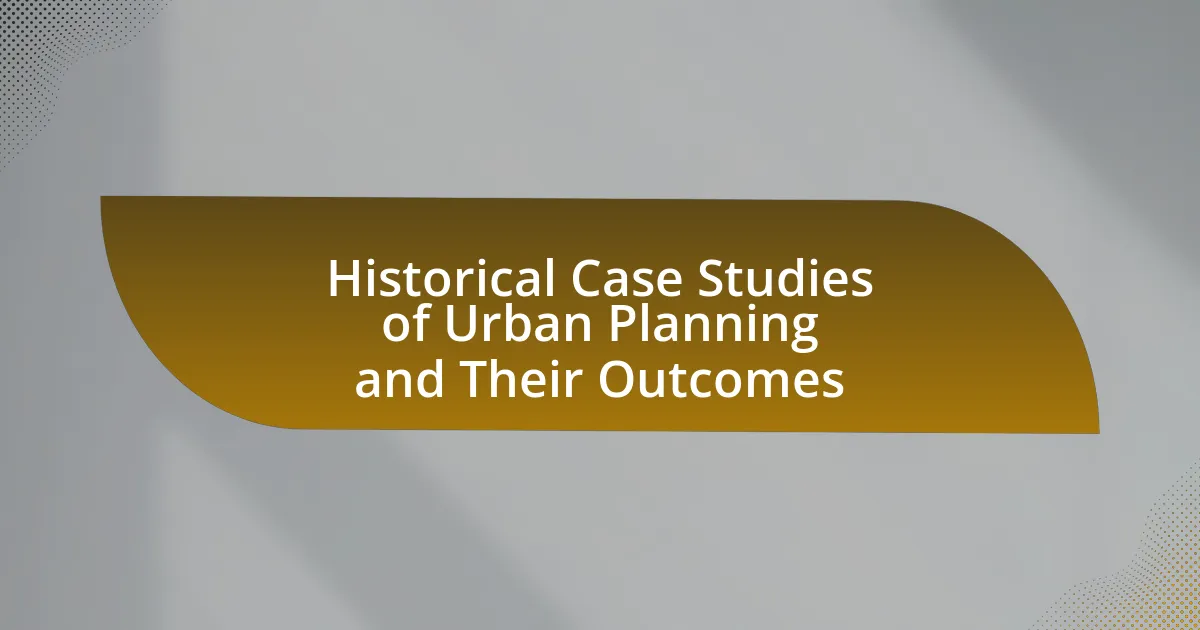The article focuses on historical case studies of urban planning, examining significant examples such as Haussmann’s Paris and the Garden City movement. It highlights how these case studies contribute to understanding urban planning by providing insights into the successes and failures of past initiatives. Key themes include the influence of historical contexts, community involvement, and the role of technology in shaping urban environments. The article also discusses methodologies for analyzing these case studies and the implications of their outcomes for modern urban planning practices, emphasizing the importance of sustainable development and social equity.

What are Historical Case Studies of Urban Planning?
Historical case studies of urban planning include significant examples such as the City of Paris under Baron Haussmann in the mid-19th century, which transformed the city through wide boulevards and improved sanitation, and the Garden City movement initiated by Ebenezer Howard in the early 20th century, which aimed to combine the benefits of both urban and rural living. These case studies illustrate the impact of strategic planning on urban development, as seen in Paris where the redesign facilitated better traffic flow and public health, and in the Garden City movement, which influenced suburban planning worldwide by promoting self-contained communities surrounded by greenbelts.
How do historical case studies contribute to our understanding of urban planning?
Historical case studies significantly enhance our understanding of urban planning by providing empirical evidence of past successes and failures in city development. These studies allow urban planners to analyze the impact of various design choices, policies, and socio-economic factors on urban environments. For instance, the case of the Garden City movement in the late 19th century illustrates how integrating green spaces into urban design can improve residents’ quality of life and promote sustainable living. Additionally, the redevelopment of post-war cities, such as the reconstruction of Berlin, offers insights into the complexities of urban renewal and the importance of community involvement in planning processes. By examining these historical examples, urban planners can draw lessons that inform contemporary practices and policies, ultimately leading to more effective and resilient urban environments.
What methodologies are used in analyzing historical urban planning case studies?
Qualitative and quantitative methodologies are used in analyzing historical urban planning case studies. Qualitative methods include archival research, interviews, and content analysis, which help in understanding the context, motivations, and outcomes of urban planning decisions. Quantitative methods involve statistical analysis of demographic data, land use patterns, and economic indicators to assess the impact of urban planning initiatives. For instance, a study by Hall and Barrett (2012) utilized both qualitative interviews and quantitative data to evaluate the effectiveness of urban renewal projects in post-war Britain, demonstrating the value of combining methodologies for comprehensive analysis.
How do historical contexts influence urban planning outcomes?
Historical contexts significantly influence urban planning outcomes by shaping the priorities, policies, and practices that guide development. For instance, post-World War II urban planning in the United States was heavily influenced by the need for rapid reconstruction and the expansion of suburban areas, leading to the creation of car-centric infrastructure and zoning laws that favored single-family homes. This historical context resulted in urban sprawl, which has had lasting effects on social dynamics, environmental sustainability, and economic disparities in urban areas. Additionally, cities like Paris underwent transformations during the Haussmannization period in the mid-19th century, where historical contexts of industrialization and public health concerns led to wide boulevards and improved sanitation, fundamentally altering urban landscapes and social interactions. These examples illustrate how historical events and societal needs directly shape urban planning decisions and their long-term outcomes.
What key themes emerge from historical urban planning case studies?
Key themes that emerge from historical urban planning case studies include the importance of community involvement, the impact of transportation infrastructure, and the balance between preservation and development. Community involvement is crucial, as seen in the participatory planning processes of cities like Portland, Oregon, which led to successful urban renewal projects. Transportation infrastructure significantly shapes urban form and accessibility, exemplified by the development of the subway systems in New York City, which facilitated population growth and economic activity. Lastly, the tension between preservation and development is highlighted in case studies like the revitalization of historic districts in cities such as New Orleans, where maintaining cultural heritage coexists with modern urban needs. These themes illustrate the multifaceted nature of urban planning and its historical context.
How do social, economic, and political factors shape urban planning decisions?
Social, economic, and political factors significantly shape urban planning decisions by influencing priorities, resource allocation, and community engagement. Social factors, such as demographics and cultural values, determine the needs and preferences of residents, guiding planners to create inclusive spaces. Economic factors, including funding availability and market trends, dictate the feasibility of projects and the types of developments pursued, as seen in the revitalization of urban areas that attract investment. Political factors, such as government policies and stakeholder interests, affect regulatory frameworks and decision-making processes, exemplified by zoning laws that reflect political agendas. Together, these factors create a complex interplay that ultimately defines the direction and success of urban planning initiatives.
What role does technology play in the evolution of urban planning?
Technology plays a crucial role in the evolution of urban planning by enabling data-driven decision-making and enhancing the efficiency of urban design processes. Geographic Information Systems (GIS) have transformed how planners visualize and analyze spatial data, allowing for better land use planning and resource allocation. For instance, cities like Barcelona have utilized smart city technologies to optimize traffic flow and reduce congestion, demonstrating the effectiveness of integrating technology into urban planning. Additionally, advancements in building information modeling (BIM) facilitate collaboration among stakeholders, improving project outcomes and sustainability. These technological innovations underscore the importance of integrating modern tools in urban planning to address complex urban challenges effectively.

What are notable historical case studies in urban planning?
Notable historical case studies in urban planning include the development of Haussmann’s Paris, the reconstruction of Berlin after World War II, and the planning of Brasília in Brazil. Haussmann’s Paris, implemented in the mid-19th century, transformed the city through wide boulevards, parks, and improved sanitation, significantly enhancing urban living conditions. The post-war reconstruction of Berlin involved extensive planning to address the destruction caused by the war, leading to a divided city that later influenced urban policies in both East and West Berlin. Brasília, designed in the 1950s by architect Oscar Niemeyer and urban planner Lúcio Costa, exemplified modernist principles and aimed to promote economic growth by relocating the capital to the interior of Brazil, showcasing the impact of urban planning on national development. Each of these case studies illustrates the profound effects of urban planning decisions on social, economic, and environmental outcomes.
Which cities provide significant examples of urban planning successes?
Copenhagen, Denmark, and Singapore are significant examples of urban planning successes. Copenhagen has implemented extensive cycling infrastructure, resulting in over 62% of its residents commuting by bike daily, which has reduced traffic congestion and pollution. Singapore’s urban planning integrates green spaces and efficient public transport, leading to a high quality of life and sustainable urban growth, with 80% of its population living in public housing that is well-connected to amenities and services. These cities exemplify effective urban planning through innovative design and sustainable practices.
What strategies were employed in successful urban planning case studies?
Successful urban planning case studies employed strategies such as community engagement, mixed-use development, and sustainable transportation systems. Community engagement involved actively involving residents in the planning process, which was evident in the case of Portland, Oregon, where public forums and workshops led to the development of the city’s comprehensive plan. Mixed-use development, as seen in the revitalization of the High Line in New York City, integrated residential, commercial, and recreational spaces, promoting walkability and economic growth. Sustainable transportation systems were exemplified by Copenhagen’s investment in cycling infrastructure, resulting in a significant increase in bike usage and a reduction in carbon emissions. These strategies collectively contributed to the effectiveness and success of urban planning initiatives.
How did community involvement impact these successful outcomes?
Community involvement significantly enhanced successful outcomes in urban planning by fostering collaboration between residents and planners. This engagement led to more tailored solutions that addressed specific local needs, resulting in projects that were more widely accepted and utilized. For instance, in the case of the High Line in New York City, community advocacy transformed an abandoned railway into a vibrant public park, demonstrating how local input can drive innovative urban renewal. Studies show that projects with strong community participation often experience higher satisfaction rates and lower resistance, as seen in the revitalization efforts in Portland, Oregon, where citizen involvement directly influenced zoning changes and public space design.
What are some historical failures in urban planning?
Some historical failures in urban planning include the Pruitt-Igoe housing project in St. Louis, which was demolished in the 1970s due to high crime rates and poor living conditions. The design of the project, characterized by high-rise buildings and a lack of community spaces, contributed to social isolation and neglect. Another example is the urban renewal efforts in Detroit during the mid-20th century, which led to the displacement of thousands of residents and the destruction of vibrant neighborhoods, ultimately resulting in economic decline and increased poverty. Additionally, the construction of the Brasília in Brazil, while intended to symbolize modernity, has faced criticism for its lack of accessibility and social integration, leading to urban sprawl and inequality. These cases illustrate the consequences of neglecting social dynamics and community needs in urban planning.
What lessons can be learned from unsuccessful urban planning initiatives?
Unsuccessful urban planning initiatives teach critical lessons about the importance of community engagement, adaptability, and comprehensive data analysis. For instance, the failure of the Pruitt-Igoe housing project in St. Louis, which was demolished in the 1970s, highlighted the necessity of involving residents in the planning process to ensure that developments meet their needs. Additionally, the project’s design flaws and lack of maintenance underscored the need for adaptability in urban planning, as conditions and community needs evolve over time. Furthermore, the failure of the Boston Big Dig project, which faced significant cost overruns and delays, illustrates the importance of thorough data analysis and realistic budgeting in planning initiatives. These examples demonstrate that neglecting these factors can lead to costly and ineffective urban developments.
How did these failures affect the communities involved?
Failures in urban planning significantly disrupted the communities involved by leading to economic decline, social fragmentation, and environmental degradation. For instance, the construction of the Cross Bronx Expressway in New York City resulted in the displacement of thousands of residents, which fractured established neighborhoods and diminished local businesses. This disruption contributed to increased poverty rates and a decline in community cohesion, as evidenced by a 2017 study from the Journal of Urban Affairs, which highlighted that areas affected by such infrastructure projects often experience long-term socioeconomic challenges. Additionally, the lack of green spaces and increased pollution from poorly planned developments have adversely impacted public health, further exacerbating the struggles faced by these communities.

What are the outcomes of historical urban planning case studies?
Historical urban planning case studies have led to various outcomes, including improved infrastructure, enhanced public spaces, and increased social equity. For instance, the implementation of the Garden City movement in the early 20th century resulted in the development of self-contained communities surrounded by greenbelts, which improved living conditions and accessibility to nature. Additionally, the urban renewal projects in cities like New York during the mid-20th century aimed to revitalize deteriorating neighborhoods, although they often displaced existing communities. These outcomes demonstrate the complex impacts of urban planning decisions on societal structures and urban environments.
How do we measure the success of urban planning initiatives?
Success in urban planning initiatives is measured through various quantitative and qualitative metrics, including community satisfaction, economic growth, environmental sustainability, and social equity. For instance, surveys assessing resident satisfaction can provide insights into how well the initiative meets community needs, while economic indicators such as job creation and property value increases can reflect financial success. Additionally, metrics like reduced traffic congestion and improved air quality can indicate environmental benefits, and analyses of access to services and amenities can highlight advancements in social equity. Historical case studies, such as the revitalization of the High Line in New York City, demonstrate these metrics in action, showing increased tourism and property values alongside enhanced community engagement.
What indicators are used to evaluate urban planning outcomes?
Indicators used to evaluate urban planning outcomes include land use efficiency, transportation accessibility, environmental sustainability, social equity, and economic viability. Land use efficiency assesses how well land resources are utilized, often measured by density and mixed-use development. Transportation accessibility evaluates the availability and convenience of transport options, typically analyzed through metrics like walkability and public transit coverage. Environmental sustainability indicators focus on factors such as green space availability and pollution levels, reflecting the ecological impact of urban planning. Social equity examines the distribution of resources and services among different demographic groups, often assessed through income levels and access to amenities. Economic viability looks at job creation, property values, and overall economic growth resulting from urban planning initiatives. These indicators provide a comprehensive framework for assessing the effectiveness and impact of urban planning strategies.
How do long-term impacts differ from short-term results in urban planning?
Long-term impacts in urban planning focus on sustainable development, community cohesion, and environmental resilience, while short-term results often prioritize immediate economic gains and quick fixes. For example, a long-term impact might involve the establishment of green spaces that enhance biodiversity and improve air quality over decades, whereas a short-term result could be the rapid construction of commercial buildings that boost local employment temporarily. Historical evidence, such as the development of Central Park in New York City, illustrates that long-term planning can lead to lasting benefits in public health and urban aesthetics, contrasting with short-term projects that may lead to congestion and resource depletion.
What are the implications of historical urban planning outcomes for modern practices?
Historical urban planning outcomes significantly influence modern practices by providing lessons on sustainability, social equity, and infrastructure development. For instance, the urban renewal projects of the mid-20th century often led to displacement and social fragmentation, highlighting the need for inclusive planning that prioritizes community engagement. Additionally, the failures of car-centric designs in cities like Los Angeles have prompted a shift towards walkable urban environments, emphasizing mixed-use developments and public transportation. These historical lessons inform current policies aimed at creating resilient, adaptable cities that address contemporary challenges such as climate change and urban sprawl.
How can historical case studies inform current urban planning strategies?
Historical case studies can inform current urban planning strategies by providing insights into successful and unsuccessful practices, allowing planners to learn from past experiences. For instance, the urban renewal projects of the mid-20th century, such as those in St. Louis and Boston, illustrate the consequences of displacing communities without adequate planning, leading to long-term social and economic issues. Analyzing these outcomes helps current planners prioritize community engagement and sustainable development. Additionally, the revitalization of cities like Copenhagen, which focused on pedestrian-friendly infrastructure and green spaces, demonstrates effective strategies that enhance livability and environmental sustainability. By examining these historical examples, urban planners can adopt best practices and avoid repeating past mistakes, ultimately leading to more effective and inclusive urban development.
What best practices can be derived from historical urban planning outcomes?
Best practices derived from historical urban planning outcomes include prioritizing mixed-use development, ensuring community engagement, and implementing sustainable transportation systems. Mixed-use development, as seen in cities like Barcelona, promotes vibrant neighborhoods by integrating residential, commercial, and recreational spaces, enhancing accessibility and reducing reliance on cars. Community engagement, exemplified by the participatory planning processes in Copenhagen, fosters a sense of ownership and ensures that developments meet the needs of residents. Sustainable transportation systems, such as those in Amsterdam, demonstrate the effectiveness of prioritizing cycling and public transit, leading to reduced congestion and improved air quality. These practices are validated by successful urban environments that have adapted to changing needs while maintaining livability and sustainability.
What practical insights can be gained from historical case studies of urban planning?
Historical case studies of urban planning provide practical insights such as the importance of community involvement, the impact of zoning laws, and the necessity of sustainable practices. For instance, the redevelopment of the High Line in New York City illustrates how community advocacy can transform underutilized spaces into vibrant public areas, enhancing urban life and property values. Additionally, the implementation of zoning regulations in cities like Los Angeles has shown how land use planning can mitigate urban sprawl and promote efficient resource use. Furthermore, the case of Curitiba, Brazil, demonstrates the effectiveness of integrated public transportation systems in reducing traffic congestion and environmental impact, highlighting the need for sustainable urban design. These examples underscore the value of learning from past urban planning efforts to inform future developments.
